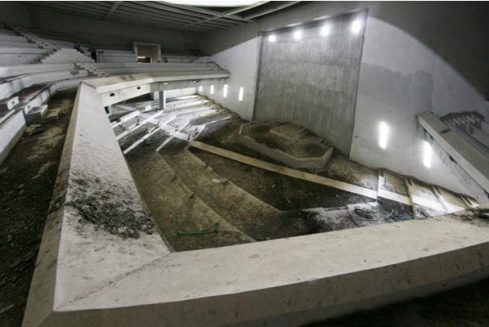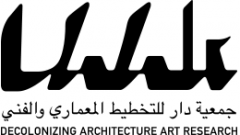Posted: 27.10.2011
Category: Uncategorized
Exhibition: DAAR at Steirischer Herbst

23/09 – 16/10
c/o Galerie Zimmermann Kratochwill & Festival district: Information and Ticket Office
Mon – Fri 12 noon – 8 pm
Sat & Sun 10.30 am – 8 pm


UN-Habitat calls for planner
UN-Habitat calls for urban planner in the area of Jerusalem.
Submission’s dead line: 14 October 2011.
Towards return of Palestinian refugees
Posted: 16.09.2011
Sedek 6 Editorial: an introduction, and an invitation
It is doubtful whether there has ever been an idea in the modern history of Israel and Palestine whose consideration of the feasibility and development of possibilities has been so rejected and neglected as that of the idea of the return of the Palestinian refugees. Israel’s denial since the end of the 1948 war of the Palestinian refugees’ right to return home has focused public attention about the refugees on the right of return, thereby banishing the development of all political vision and practice from the public debate.
Sedek 6 is a challenge to this negation, which has effectively imposed a freeze on the return of the Palestinian refugees as a practical possibility. Sedek 6 provides a tri-lingual textual and visual platform for initial experiences in thinking – political, visionary, and planning – toward the return of the Palestinian refugee
Design Studio at the Berlage Institute
Posted: 12.09.2011
27 September 2011, 12:00–19:00
Opening Conference, Introduction of the Academic Year Program 2011-2012
Berlage Institute, Botersloot 25, 3011 HE Rotterdam, The Netherlands
Eyal Weizman at University of Bergen and Columbia University
Posted: 10.09.2011
Hollow Land: Landscape, Memory, Politics
The Fourth Nomadikon Meeting
Bergen, September 20, 2011
The event is jointly organized by the research project Nomadikon: New Ecologies of the Image and the Centre for Middle Eastern and Islamic Studies at the University of Bergen, and is open to the public.
Part One
Egget, Student Centre, University of Bergen, Parkveien 1
14.45 Words of welcome
Asbjørn Grønstad, Nomadikon, and Knut Vikør, Centre for Middle Eastern and Islamic Studies
15.00 – 16.30
Øyvind Vågnes, “’What has happened in a place is always happening’: Reflections on Footnotes in Gaza”
Kjersti G. Berg, “Humanitarian Governance and the Construction of Palestinian Refugee Camps”
Henrik Gustafsson, “Site, Speech and Silence”
16.30 Break, Coffee, Fruit, Pastry
17.00 – 18.15
W.J.T. Mitchell, “Art X Environment: Extreme Social Landscapes”
Includes a screening of Khaled Jarrar’s Journey 110 (2009, 13 min)
18.15 Break,
Coffee
18.30-19.30
Eyal Weizman, “Decolonizing Architecture”
Part Two
Landmark, Bergen Kunsthall, Rasmus Meyers allé 5
20.00 Joe Sacco, “Recreating Place and Time in Comics”
+
Injured Cities, Urban Afterlives
A conference cosponsored by the Barnard Center for Research on Women and the Center for the Critical Analysis of Social Difference at Columbia University
FRIDAY, OCTOBER 14, 2011 – SATURDAY, OCTOBER 15, 2011
MILLER THEATER AND WOOD AUDITORIUM, COLUMBIA UNIVERSITY
What are the effects of catastrophe on cities, their inhabitants, and the larger world? How can we address the politics of terror with which states react to their vulnerability? This conference, convened ten years after September 11, 2001, aims to explore the effects of catastrophe and to imagine more life-affirming modes of redress and reinvention. In a series of presentations and conversations, an international group of artists, writers, and activists will imagine creative responses to disaster and initiate a new collective memory of the events of September 11. Speakers include Ariella Azoulay, Nina Bernstein, Hazel Carby, Teddy Cruz, Ann Jones, Dinh Q. Lê, Shirin Neshat, Walid Raad, Saskia Sassen, Karen Till, Clive van den Berg, Eyal Weizman, and narrators from the September 11, 2001 Oral History Project at Columbia.
Exhibition: COMMON ASSEMBLY Deterritorializing the Palestinian Parliament
Posted: 05.09.2011

Photo:Carina Ottino
The Palestinian Legislative Council building – known as the Palestinian Parliament – is simultaneously a construction site and a ruin. It collapsed not by the military violence that saturates our region but by the failure of a form of politics now challenged throughout the Middle East. The building is only one of the several Palestinian Parliaments scattered within historical Palestine and in the diaspora. Other “fragments” of Parliaments (Ramallah, Gaza, Jordan) and the traces of the erosion of Palestinian representation are present in many areas in which the political struggle wandered in the last decades. But that under discussion is probably one of the most representative remains able to trigger the rearticulation of a new and shared political imagination.
Construction began in 1996, during the euphoria produced by the Oslo process. Its location is the product of political maneuvering. Some prominent members of the Palestinian leadership wanted to push the building as close as possible to the Al Aqsa mosque—a stepping stone towards the ultimate establishment of East Jerusalem as the capital of the Palestinian State —while Israeli leadership, military and settlers were simultaneously pushing the Parliament outside their unilaterally declared border of Jerusalem. Consequently, the Parliament wound up in Abu Dis, a peripheral Jerusalem neighborhood. In 2003, after the collapse of the Oslo Process, the eruption of the Second Intifada, and the construction of the Wall just a few meters from the building, construction on the Parliament was halted and the building was left empty: a massive relic and a testimony to the failure of political negotiations.
Our project began with the discovery that – mistakenly or intentionally – the building was not built beside the border, but rather, that the border runs right through the building. Following DAAR’s methodology, which attempts to exploit opportunities found within colonial separations, our project seeks both to de-territorialize and re-activate this legal anomaly. .
Upon discovering that the Israeli imposed Jerusalem border passes through the Parliament, it became clear that the building is sitting, paradoxically, within three different spaces: part within Israeli territory, part within Palestinian controlled territory, and a small strip, no larger than the line’s thickness, exists in a legal and sovereign limbo— potentially an extra-territorial zone. Thus we seek to reimagine the building, and its politically and legally suspended status, as an assembly that is able to represent all Palestinians: those living in Israel, under its occupation, and in exile.The activation of an assembly in a legal and political void constitutes a way of thinking and rethinking a space of relationality, horizontality and shared liberation on which colonial reason and the expropriators of the common have built their fortunes.
DAAR
Sandi Hilal, Alessandro Petti, Eyal Weizman
Directed by Alessandro Petti
“Common Assembly: Deterritorializing the Palestinian Parliament”
A project by Sandi Hilal, Alessandro Petti, Eyal Weizman, Nicola Perugini
with Yazeed Anani, Nishat Awan, Ghassan Bannoura, Benoit Burquel, Suzy Harris-Brandts, Runa Johannessen, Zografia Karekou, Cressida Kocienski, Lejla Odobasic, Carina Ottino, Elizabeth Paden, Sameena Sitabkhan, Amy Zion.
“Common Assembly: Deterritorializing the Palestinian Parliament” is the second collaborative partnership between DAAR, the Al-Quds Bard Honors College and the Forensic Architecture project, at the Centre for Research Architecture, Goldsmiths, University of London. It is supported by Foundation for Arts Initiatives and the Municipality of Beit Sahour. The International Summer Research and Internship Program took place during the summer of 2011 in Beit Sahour, near Bethlehem. It involved students, architects, NGO staff and village officials. The residency in collaboration with Delfina Foundation included 15 international architects and artists, 15 students from the Al-Quds Bard Honors College as well as local and internationals experts invited to present lectures and participate in seminars.
September 16 to October 28 2011
Centre d’Art Neuchâtel
37, rue des Moulins
CH-2000 Neuchâtel
T : 032 724 01 60
E : info(at)can.ch
Horaires d’ouvertures (en période d’exposition) :
Mercredi au dimanche : 14h-18h
Jeudi : 14h-20h
Le CAN est ouvert les jours feriés
Prix d’entrée : 5.- / 2.50
Exhibition and presentation: Creative Summit: Living as a From
Posted: 02.09.2011
30+ Artists, Curators, and Thinkers present their work engaging pressing issues affecting our world
September 23, 2011. Skirball Center for the Performing Arts, NYU
This year’s Summit is presented in conjunction with Living as Form. Over 100 Artists and Projects, 25 Curators and 9 New Commissions Highlighting 20 Years of Socially Engaged Art. September 24 – October 16, 2011. The Historic Essex Street Market
Curated by Nato Thompson
An annual conference bringing together cultural producers to discuss how their work engages pressing issues affecting our world.
The Creative Time Summit includes cultural producers whose international projects consist of a vast array of practices and methodologies that engage with the canvas of everyday life. Participants range from art world luminaries to those purposefully obscure, providing a glimpse into an evolving community concerned with the political implications of socially engaged art. This third iteration of the Summit features presenters with projects in the Living as Form archive.
The third annual Leonore Annenberg Prize for Art and Social Change is a $25,000 award, generously supported by the Annenberg Foundation, honoring an artist who has committed his or her life’s work to promoting social justice in surprising and profound ways. Past recipients include The Yes Men and Rick Lowe.
Exhibition: The Lawless line
Posted: 01.09.2011
Second Worlds: herbst exhibition (81% visual arts 19% vision of the future)
Curated by What, How & for Whom / WHW (HR)
23/09 – 16/10 c/o Galerie Zimmermann Kratochwill & Festival district
Exhibition opening: Fri 23/09 5 pm
Second Worlds: in which the past had different consequences and the future does not depend on the present. Parallel worlds, possible worlds, impossible worlds, ideal worlds. Worlds apart, worlds connected. The programme invokes the unrealised possibilities haunting our present day, as well as the realistic dangers that could wipe out any conceivable future.
The notion of another world has become largely apocalyptic – a world in the wake of an unimaginable natural disaster, for example, or a human-induced self-destruction with capital as the sole survivor. The geopolitical construction of a second world from the Cold War era, that for decades euphemistically sought to conceal the dark chasm between the First and Third Worlds with the illusion of progress that would, sooner or later, embrace all people, has gone out of fashion. But the inequalities and divisions that it manifested have continued to grow. Only the ideology of economic growth has superseded that of progress.
This year’s herbst exhibition – conceived by the Croatian curator collective WHW, who were, amongst other things, responsible for the Istanbul Biennial 2009 – uses the potential of possible and impossible second worlds as a projection surface for an imaginary and political change of perspective – but still firmly rooted in the geopolitical reality of our time.
With Jumana Emil Abboud (PS), Yael Bartana (IL), Nemanja Cvijanović (HR/I), Marcelo Expósito & Verónica Iglesia (E/ARG), Decolonizing Architecture Art Residency / DAAR (PS), Ruben Grigorian (ARM), Bouchra Khalili (F/MA), Daniel Knorr (D/RO), Tom Nicholson (AUS), Maha Maamoun (EG), Mona Marzouk (EG), Chan-Kyong Park (ROK), Lala Raščić (HR/USA), Marko Tadić (HR)
TEDxRamallah – Alessandro Petti أليساندرو بيتي – Decolonizing The Mind
Posted: 10.07.2011
[youtube]http://www.youtube.com/watch?v=xcfdqtOq6IA[/youtube]
